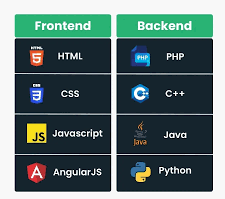Difference Between Frontend and Backend: Frontend vs. Backend

The front end and the back end are two separate but interdependent parts of web development that work together to make websites and web apps work. Understanding the differences between these two web development pillars is important for anyone who wants to learn how to build modern websites.
Introduction:
When it comes to web development, there are two main areas that developers work in: the front end and the back end. Individually, they are all very important for making websites and web apps work. The front end controls what users see and how they interact with it. The backend controls data, logic, and server-side operations that make the front end work. Let’s learn more about frontend and backend by looking at their features, technologies, and how they are different.
What is a frontend?
The part of a website or web app that users directly interact with is called the frontend. This is also called client-side development. It includes everything that browser users see, touch, and do, such as the layout, design, content, and interactive parts. Frontend development is all about making an interface that is interesting and easy to use, which improves the user experience.
What is a backend?
Backend, also known as server-side development, refers to the part of a website or web application that users do not directly interact with. It includes the server, database, and application logic that work behind the scenes to process requests, retrieve data, perform calculations, and generate dynamic content. Backend development focuses on ensuring the functionality, security, and performance of the application’s server-side operations.
Features of Frontend:
- User Interface (UI): Frontend development encompasses the design and implementation of full-stack front-end user interface (UI) elements, including buttons, forms, menus, and navigation bars, to deliver an intuitive and visually appealing user experience.
- Responsiveness: Frontend developers are responsible for ensuring that websites and web applications are responsive across various devices and screen sizes to provide a seamless user experience on desktops, laptops, tablets, and smartphones.
- Interactivity:Frontend development allows for the integration of interactive elements like animations, sliders, carousels, and pop-ups to engage users and enhance user interaction.
- Accessibility: Frontend developers prioritize accessibility by ensuring that websites and web applications are usable by people with disabilities. This includes incorporating features such as screen reader compatibility and keyboard navigation.
- Performance Optimization: Frontend developers improve website and web application performance by minimizing load times, reducing file sizes, and using techniques such as lazy loading and caching.
Features of the backend:
- Data management: managing the storage, retrieval, and manipulation of data is part of backend development. File systems, databases, and APIs are used to store and retrieve data from servers.
- Business Logic: Backend developers are responsible for implementing the business logic of applications. This includes handling algorithms, calculations, and decision-making processes to process user inputs, execute operations, and generate dynamic responses.
- Security: Backend development involves implementing security measures to protect against threats such as unauthorized access, data breaches, and injection attacks. These measures include authentication, authorization, encryption, and data validation.
- Scalability: Backend developers are responsible for designing scalable architectures and infrastructure, utilizing technologies like cloud computing, microservices, and containers to manage increasing user loads and maintain application performance and availability.
- Integration: Backend development involves integrating external services, APIs, and third-party libraries to extend the functionality of applications and leverage external resources for tasks such as payment processing, email delivery, and social media integration.
Technologies Involved in Web Development:
Web development involves a variety of technologies, programming languages, and frameworks that support the creation of websites and web applications. Below are some key technologies used in front-end and back-end development:
Front-End Development Languages:
- HTML (HyperText Markup Language): HTML is the standard markup language used to create the structure and content of web pages.
- CSS (Cascading Style Sheets): CSS is used to style and format the visual presentation of HTML elements, including layout, colors, fonts, and animations.
- JavaScript: JavaScript is a scripting language that enables interactive and dynamic functionality on web pages, including event handling, DOM manipulation, and asynchronous communication.
Front-End Frameworks:
- React: React is a JavaScript library for building user interfaces, developed by Facebook. It facilitates the creation of reusable UI components and provides tools for managing state and handling data.
- Angular: Angular is a TypeScript-based framework for building single-page applications, developed by Google. It provides a comprehensive platform for front-end development, including features such as dependency injection, routing, and form handling.
- Vue.js: Vue.js is a progressive JavaScript framework for building user interfaces, known for its simplicity and versatility. It allows developers to create interactive web applications with ease using components, directives, and reactive data binding.
Back-End Development Languages:
- JavaScript (Node.js): Node.js is a runtime environment that allows developers to run JavaScript on the server side. It enables non-blocking, event-driven I/O operations, making it well-suited for building scalable and high-performance backend applications.
- Python: Python is a versatile programming language known for its simplicity and readability. It is widely used for backend development, thanks to its extensive libraries and frameworks, such as Django and Flask, which streamline the development process.
- Ruby: Ruby is a dynamic, object-oriented programming language known for its simplicity and productivity. It is commonly used with the Ruby on Rails framework for building web applications, offering features such as scaffolding, ORM, and convention over configuration.
Back-End Frameworks:
- Express.js: Express.js is a minimalist web framework for Node.js, designed for building web applications and APIs. It provides a robust set of features for routing, middleware, and HTTP request handling, making it a popular choice for backend development.
- Django: Django is a high-level Python web framework known for its scalability, security, and built-in features. It follows the “batteries-included” philosophy, providing out-of-the-box functionality for authentication, administration, and ORM.
- Ruby on Rails: Ruby on Rails, often referred to as Rails, is a full-stack web framework for Ruby known for its conventions over configuration and rapid development principles. It simplifies common tasks such as routing, database migrations, and testing, allowing developers to focus on building features.
Difference Between Frontend and Backend:
While frontend and backend development share the common goal of creating functional and visually appealing web solutions, they differ significantly in their focus, responsibilities, and technologies:
- Focus: Frontend development focuses on creating the user interface and client-side functionality, while backend development focuses on managing data, business logic, and server-side operations.
- Responsibilities: Frontend developers are responsible for designing, implementing, and optimizing the user interface, ensuring a seamless and engaging user experience. Backend developers, on the other hand, handle data management, business logic, security, and scalability, ensuring the robustness and reliability of the application’s backend infrastructure.
- Technologies: Frontend development typically involves HTML, CSS, and JavaScript, along with frontend frameworks like React, Angular, or Vue.js. Backend development encompasses languages like JavaScript (Node.js), Python, or Ruby, along with backend frameworks like Express.js, Django, or Ruby on Rails.
- Interactivity: Frontend development enables the integration of interactive elements, animations, and user interfaces to engage users and enhance the user experience. Backend development focuses on processing user inputs, executing operations, and generating dynamic responses based on business logic and data processing.
- Visibility: Frontend development is visible to users and directly impacts their interaction with the application, while backend development is invisible to users and operates behind the scenes to manage server-side operations and data processing.
Full-Stack Web Development:

In addition to frontend and backend development, there is another role known as full-stack web development, which encompasses both frontend and backend development responsibilities. Full-stack developers are proficient in both client-side and server-side technologies, allowing them to design, implement, and maintain end-to-end web solutions.
Conclusion:
In conclusion, understanding the differences between front-end and back-end development is essential for anyone involved in web development. While frontend development focuses on creating the user interface and client-side functionality, backend development focuses on managing data, business logic, and server-side operations. By leveraging the right technologies and frameworks for frontend and backend development, developers can create robust, scalable, and user-friendly web solutions that meet the needs of modern users.
Frequently Asked Questions:
Q.1: Is C++ front-end or back-end?
C++ can be used for both frontend and backend development, although it is more commonly associated with backend development due to its performance and systems-level capabilities. However, with the advent of frameworks like Qt, C++ can also be used for front-end development, particularly for building desktop applications.
Q.2: Which pays more? Front end or back end?
Salaries for frontend and backend developers can vary depending on factors such as location, experience, and demand. In general, backend developers tend to earn slightly higher salaries due to the complexity and specialized skills required for backend development.
Q.3: Is front-end development dying?
No, front-end development is not dying. It is thriving due to the increasing demand for interactive and visually appealing web applications. With the proliferation of JavaScript frameworks and libraries, front-end development has become more accessible and powerful than ever before.
Q.4: Is the front end a good career?
Yes, frontend development is a lucrative and rewarding career choice. As businesses continue to prioritize user experience and interface design, the demand for skilled frontend developers is expected to remain strong in the foreseeable future.
Q.5: Is Python for the front end or the back end?
Python can be used for both front-end and back-end development. While Python is commonly associated with backend development, thanks to frameworks like Django and Flask, it can also be used for frontend development with libraries like Django templates or frameworks like PyQT.
Q.6: Should I learn the front end or the back end first?
There is no right or wrong answer to this question, as it ultimately depends on your interests, goals, and learning preferences. Some developers prefer to start with frontend development to gain a better understanding of user interface design and user experience, while others prefer to start with backend development to delve into data management and server-side logic. Ultimately, learning both frontend and backend development is beneficial for becoming a well-rounded web developer.
 Data Science in Digital Marketing Data Science in Digital Marketing: Mechanism Examples, Benefits Data Science Meets Digital Marketing Magic
Data Science in Digital Marketing Data Science in Digital Marketing: Mechanism Examples, Benefits Data Science Meets Digital Marketing Magic
